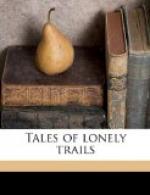Nielsen told of some men who were massacred by Seris on the mainland opposite Tiburon Island. One man, who had gone away from camp, returned to hear the attack upon his companions. He escaped and made his way to Gyamus. Procuring assistance this man returned to the scene of the massacre, only to find stakes in the sand, with deep trails tramped around them, and blackened remains of fires, and bones everywhere. Nielsen went on to say that once from a hiding place he had watched Seris tear up and devour a dead turtle that he afterward ascertained was putrid. He said these Seris were the greatest runners of all desert savages. The best of them could outrun a horse. One Seri, a giant seven feet tall, could outrun a deer and break its neck with his hands.
These statements of Nielsen’s were remarkable, and personally I believed them. Men of his stamp were honest and they had opportunities to learn strange and terrible facts in nature. The great naturalist Darwin made rather stronger claims for the barbarism of the savages of Terra del Fuego. Nielsen, pursuing his theme, told me how he had seen, with his own eyes—and they were certainly sharp and intelligent—Yaqui Indians leap on the bare backs of wild horses and locking their legs, stick there in spite of the mad plunges and pitches. The Gauchos of the Patagonian Pampas were famous for that feat of horsemanship. I asked Joe Isbel what he thought of such riding. And he said: “Wal, I can ride a wild steer bare-back, but excoose me from tacklin’ a buckin’ bronch without saddle an’ stirrups.” This coming from the acknowledged champion horseman of the southwest was assuredly significant.
At five o’clock we came to the end of the road. It led to a forest glade, overlooking the stream we had followed, and that was as far as our wagon could go. The glade shone red with sumach, and surrounded by tall pines, with a rocky and shady glen below, it appeared a delightful place to camp. As I was about to unsaddle my horses I heard the cluck-cluck of turkeys. Pulling out my borrowed rifle, and calling Romer, I ran to the edge of the glade. The shady, swift stream ran fifty feet or so below me. Across it I saw into the woods where shade and gray rocks and colored brush mingled. Again I heard the turkeys cluck. “Look hard, son,” I whispered. “They’re close.” R.C. came slipping along below us, with his rifle ready. Suddenly Romer stiffened, then pointed. “There! Dad!—There!” I saw two gobblers wade into the brook not more than a hundred and fifty feet away. Drawing down with fine aim I fired. The bullet splashed water all over the turkeys. One with loud whirr of wings flew away. The other leaped across the brook and ran—swift as a deer—right up the slope. As I tried to get the sight on him I heard other turkeys fly, and the crack-crack of R.C.’s gun. I shot twice at my running turkey, and all I did was to scatter the dirt over him, and make him run faster. R.C. had not done any better shooting. Romer, wonderful to relate, was so excited that he forgot to make fun of our marksmanship. We scouted around some, but the turkeys had gone. By promising to take Romer hunting after supper I contrived to get him back to the glade, where we made camp.




